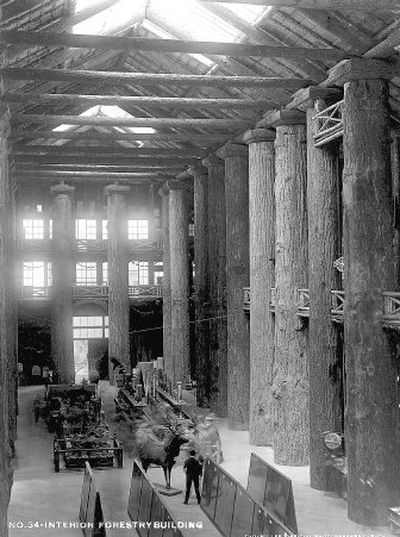The world came to Portland

PORTLAND – In the summer of 1905, more than a million people traveled to Portland, paying a few cents each to marvel at the wonders and technology of the day.
They watched flying dirigibles. They saw dials register an unseen force called electricity on the Voltmeter. They heard scratchy, giddy recordings of their own voices created by the Dictaphone.
All were on view at the world’s fair, held in Portland to celebrate the centennial of Meriwether Lewis and William Clark’s arrival on the Pacific Coast.
A century later, the Oregon Historical Society has re-created life-size versions of the exposition’s exhibits to give visitors the experience of walking through the 1905 world’s fair.
“A Fair to Remember: The 1905 Lewis and Clark Exposition” is a part of three years of events being held throughout the United States to mark the bicentennial of the 1804-1806 Voyage of Discovery.
The exhibit has been set up in a large room at the Historical Society, which is Oregon’s main history museum.
A 20-foot-tall picture of the fair’s Grand Colonnade is at the entrance. Ladies in frilly, ankle-length gowns walk arm-in-arm with suited gentlemen along a columned walkway.
“We wanted to immediately give people a sense of the scale of this event,” said Lisa Berndt, curator of the show. “Throughout the exhibit we have huge murals, to give them that sense.”
Also on display are a Benson automobile under a glass case, movies similar to those shown at the fair, and blueprints of the large buildings constructed just for the 1905 fair.
Another large photo shows the exposition’s huge Forestry Building, which was built from whole, 32-ton trees. The trees were stacked horizontally to form walls of the building. Trees also served as columns, holding up a 70-foot-tall vaulted chamber.
“They were blown away by the Forestry Building,” said Carl Abbott, consultant to the exhibit and writer of “The Great Extravaganza: Portland and the Lewis and Clark Exposition.”
The trees used in the building were cut along the lower Columbia River and their size “spoke to Oregon’s role as a provider of natural resources,” he said.
Descriptions of the 1905 fair are placed around the exhibit. They explain how the fair changed the face of Portland, spurring economic, cultural and civic growth.
World’s fairs took place in cities all over the country every few years beginning in 1853 and were great diversions of the day. For the 1905 exposition, trains made traveling to Portland affordable for many people living outside the Northwest.
“Fares came down, and it was possible to put your family on the train in Chicago, travel out to Oregon, see the fair, maybe take the train to the coast and then go back home,” Abbott said.
The expo’s midway was called “The Trail,” and it had touches of the exotic. Dancing women from the streets of Cairo, live insects and the bones of a dodo bird were just a few stops along “The Trail.”
Many people returned home from the exposition with stories of innovations and oddities for families who had never dreamed of such things. They also took home souvenirs, and the historical society’s exhibit displays some of them: salt shakers, a cigar case, a pair of scissors, tea cups and a pocket knife, all bearing the Lewis and Clark Exposition logo.
Portland’s population jumped after the world’s fair – by about 100,000 between 1905 and 1912 – and its relatively flat skyline became dotted with 12-story buildings.
Historian Joseph Gaston said in 1911: “The very decision to hold the exposition strengthened every man who put down a dollar for it; and from that very day, Portland business, Portland real estate, and Portland’s great future commenced to move up.”
Going to the fair could very well have been the trip of a lifetime in an era when people often lived and died in the same county where they were born, said curator Berndt.
“The fair delivered the world to their doorstep,” she said. “They could see an Australian boomerang expert, a Coast Guard lifesaving drill, participate in a Japanese peace ceremony and see goods and inventions from around the world.”
It was a huge party that lasted 137 days, Berndt said, and it touched many people.
“There was a real uptick to the community after the fair,” she said. “And there was also a shift in mind-set. Even years afterward, people talked about the old Portland versus the new Portland and the watershed event was the fair.”